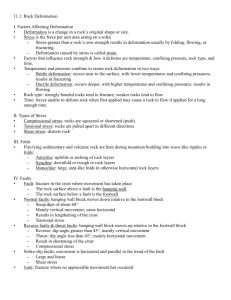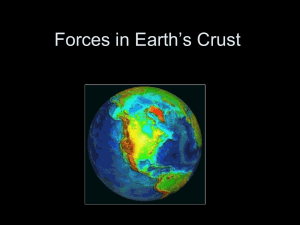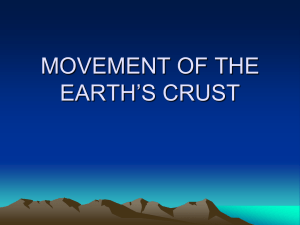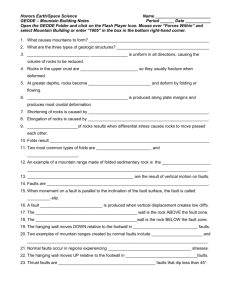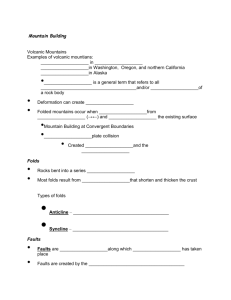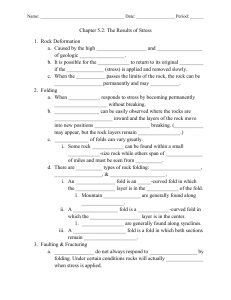Earth,Notes,RevQs,Ch10
advertisement
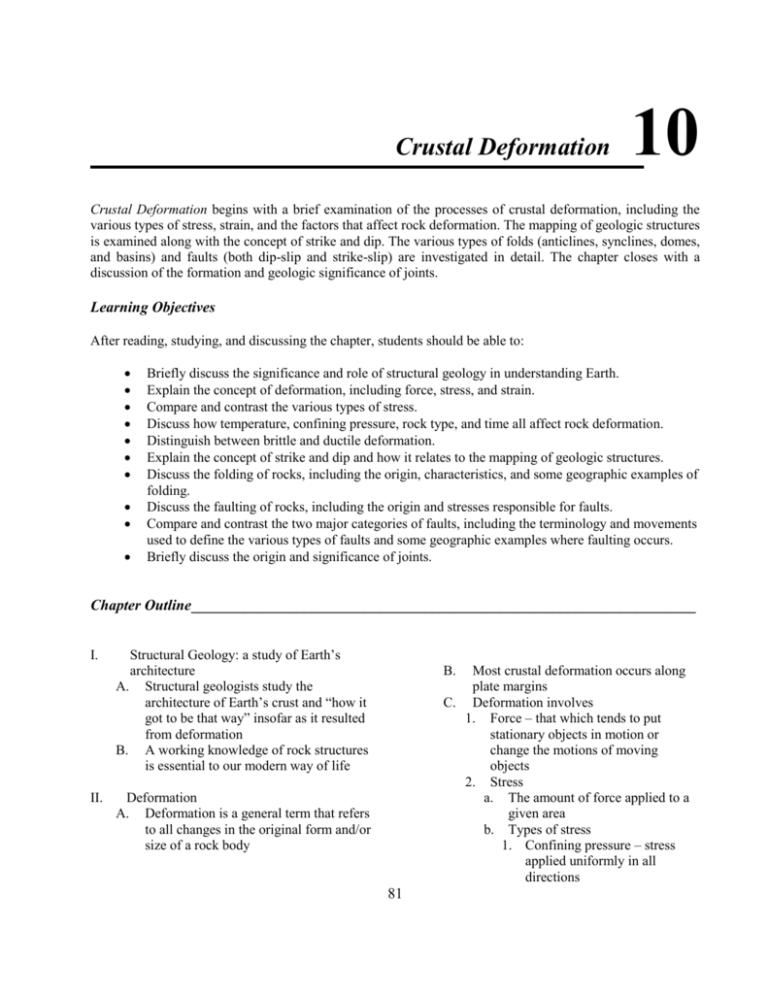
Crustal Deformation 10 Crustal Deformation begins with a brief examination of the processes of crustal deformation, including the various types of stress, strain, and the factors that affect rock deformation. The mapping of geologic structures is examined along with the concept of strike and dip. The various types of folds (anticlines, synclines, domes, and basins) and faults (both dip-slip and strike-slip) are investigated in detail. The chapter closes with a discussion of the formation and geologic significance of joints. Learning Objectives After reading, studying, and discussing the chapter, students should be able to: Briefly discuss the significance and role of structural geology in understanding Earth. Explain the concept of deformation, including force, stress, and strain. Compare and contrast the various types of stress. Discuss how temperature, confining pressure, rock type, and time all affect rock deformation. Distinguish between brittle and ductile deformation. Explain the concept of strike and dip and how it relates to the mapping of geologic structures. Discuss the folding of rocks, including the origin, characteristics, and some geographic examples of folding. Discuss the faulting of rocks, including the origin and stresses responsible for faults. Compare and contrast the two major categories of faults, including the terminology and movements used to define the various types of faults and some geographic examples where faulting occurs. Briefly discuss the origin and significance of joints. Chapter Outline___________________________________________________________________ I. II. Structural Geology: a study of Earth’s architecture A. Structural geologists study the architecture of Earth’s crust and “how it got to be that way” insofar as it resulted from deformation B. A working knowledge of rock structures is essential to our modern way of life B. Most crustal deformation occurs along plate margins C. Deformation involves 1. Force – that which tends to put stationary objects in motion or change the motions of moving objects 2. Stress a. The amount of force applied to a given area b. Types of stress 1. Confining pressure – stress applied uniformly in all directions Deformation A. Deformation is a general term that refers to all changes in the original form and/or size of a rock body 81 82 CHAPTER 10 2. Differential stress – applied unequally in different directions a. Compressional stress – shortens a rock body b. Tensional stress – tends to elongate or pull apart a rock unit c. Differential stress can also cause a rock to shear – a motion similar to the slippage that occurs between individual playing cards when the top of the deck is moved relative to the bottom d. Strain – irreversible change in the shape and size of a rock body caused by stress D. How rocks deform 1. Rocks subjected to stress greater than their own strength begin to deform usually by a. Folding b. Flowing, or c. Fracturing 2. General characteristics of rock deformation a. Elastic deformation 1. The rock returns to nearly its original size and shape when the stress is removed 2. Once the elastic limit (strength) of a rock is surpassed, it either a. Flows (ductile deformation), or b. Fractures (brittle deformation) b. Factors that influence the strength of a rock and how it will deform 1. Temperature 2. Confining pressure 3. Rock type 4. Time III. Mapping geologic structures A. When conducting a study of a region, a geologist identifies and describes the dominant rock structures 1. Usually only a limited number of outcrops, sites where bedrock is exposed at the surface, are available 2. Work is aided by advances in a. Aerial photography b. Satellite imagery, and c. Global Positioning Systems (GPS) B. Describing and mapping the orientation or attitude of a rock layer or fault surface involves determining the features 1. Strike (trend) a. The compass direction of the line produced by the intersection of an inclined rock layer or fault, with a horizontal plane b. Generally expressed as an angle relative to north (e.g., N10°E) 2. Dip (inclination) a. The angle of inclination of the surface of a rock unit or fault measured from a horizontal plane b. Includes both 1. An angle of inclination, and 2. A direction toward which the rock is inclined 3. The direction of dip is always at a 90° angle to the strike IV. Folds A. During crustal deformation rocks are often bent into a series of wavelike undulations called folds B. Characteristics of folds 1. Most folds result from compressional stresses which shorten and thicken the crust 2. Parts of a fold a. Limbs – refers to the two sides of a fold b. Axis – a line drawn down the points of maximum curvature of each layer Crustal Deformation 1. Horizontal, or parallel to the surface, or 2. Inclined at an angle to the surface known as the plunge c. Axial plane – an imaginary surface that divides a fold as symmetrically as possible C. Common types of folds 1. Anticline – upfolded, or arched, rock layers 2. Syncline – downfolds, or troughs, of rock layers 3. Depending on their orientation, anticlines and synclines can be a. Symmetrical – limbs are mirror images of each other b. Asymmetrical – limbs are not mirror images of each other c. Recumbent – an overturned fold d. Where the ends of folds die out, they are said to be plunging 4. Monoclines – large, step-like folds in otherwise horizontal sedimentary strata D. Other types of folds 1. Dome a. Upwarped displacement of rocks b. Circular, or slightly elongated structure c. Oldest rocks in center, younger rocks on the flanks d. May contain hogbacks – prominent angular ridges formed by outcroppings of resistant strata that have resulted from differential erosion 2. Basin a. Circular, or slightly elongated structures b. Downwarped displacement of rocks c. Youngest rocks are found near the center, oldest rocks on the flanks V. 83 Faults A. Faults are fractures (breaks) in rocks along which appreciable displacement has taken place B. Sudden movements along faults are the cause of most earthquakes C. Classified by their relative movement which can be 1. Horizontal 2. Vertical, or 3. Oblique D. Types of faults 1. Dip-slip fault a. Movement is primarily parallel to the dip (or inclination) of fault surface b. May produce long low cliffs called fault scarps c. Parts of a dip-slip fault 1. Hanging wall – the rock surface that is immediately above the fault 2. Footwall – the rock surface below the fault d. Types of dip-slip faults 1. Normal fault a. Hanging wall block moves down relative to the footwall block b. Accommodate lengthening, or extension, of the crust c. Most are small, with displacements of only a meter or so d. Large scale normal faults 1. Associated with structures called faultblock mountains 2. e.g., Teton Range of Wyoming and Sierra Nevada of California e. Prevalent at spreading centers where plate divergence occurs 84 CHAPTER 10 Forms a central block, called a graben, bounded by normal faults as the plates separate 2. Grabens produce an elongated valley bounded by uplifted structures called horsts 2. Reverse and thrust faults a. Hanging wall block moves up relative to the footwall block 1. Reverse faults have dips greater than 45° 2. Thrust faults have dips less than 45° b. Accommodate shortening of the crust c. Strong compressional forces 2. Strike-slip fault a. Dominant displacement is horizontal, and parallel to the strike of the fault b. Types of strike-slip faults 1. Right-lateral – as you face the fault, the crustal block on the opposite side of the fault moves to the right Left-lateral – as you face the fault, the crustal block on the opposite side of the fault moves to the left 3. Transform fault a. Large strike-slip fault that cuts through the lithosphere b. Accommodates motion between two large crustal plates 1. 2. VI. Joints A. Fractures called joints are among the most common rock structure B. Most occur in roughly parallel groups C. With the exception of columnar joints and curved joints associated with sheeting, most joints are produced when rocks in the outermost crust are deformed. D. Significance of joints 1. Chemical weathering tends to be concentrated along joints 2. Most important mineral deposits are emplaced along joint systems 3. Highly jointed rocks often represent a risk to construction projects Answers to the Review Questions 1. Rock deformation describes how the shape and volume of a rock change in response to stress. Think of a small, reference cube or sphere embedded in an undeformed rock. With the application of stress, the rock deforms (undergoes strain) and any changes in the volume and dimensions of the reference object are recorded by the strain. Depending on the magnitude and type of stress involved, deformation may also produce changes in the location and orientation of a rock. 2. Five geologic structures associated with deformation are anticlines, synclines, normal faults, strike-slip faults, and joints. The type of geologic structure(s) formed in a given area is dependent upon several factors including the type of applied stress, rock type, temperature, confining pressure, and time. Crustal Deformation 85 3. Stress is closely related to force although the two are technically not the same. Force refers to any action that tends to put stationary objects into motion or change the motion of moving objects. Stress refers to the amount of force applied to a given area. Therefore, stress is force that is specified over a defined area. 4. Compressional stress is a type of differential stress (applied unequally in different directions) that tends to shorten or squeeze a rock body. Shortening occurs in the direction parallel to the direction of the compressional stress and elongation or stretching occurs in the direction perpendicular to the compressional stress. Compressional stresses are associated with tectonic plate collisions where Earth’s crust is shortened and thickened by folding, flowing, and faulting. Tensional stress works in the opposite of compressional stress in that it tends to stretch or elongate a rock body. Tensional stresses occur where tectonic plates are pulled apart at divergent plate boundaries. 5. Shearing refers to the unequal or step-wise slippage that occurs to parallel layers or surfaces when differential stresses are applied. It is similar to the movements between individual playing cards when the top of the deck is moved relative to the bottom. In a near-surface environment, where temperatures and confining pressures are low, shearing often occurs on closely spaced surfaces of weakness such as bedding planes, foliation, and joints. At greater depths, temperature and confining pressures are higher and shearing is accomplished by solid state flow. 6. As discussed above, stress is force applied over a certain area. The irreversible changes in the size and shape of an object produced by stress is known as strain. Therefore, strain can be thought of as the permanent deformation that results from stress. 7. Brittle deformation describes material failure by cracking and rupture. Faults and joints in rocks are good examples. Brittle deformation is favored by shallow depths, low rock temperatures, and massive rigid rocks. Ductile deformation describes material failure by internal flowage; recrystallization is usually involved, especially at elevated temperatures. Ductile deformation is enhanced by elevated temperatures and confining pressures. Folding at great depths and elevated temperatures is accomplished by ductile (plastic) flowage without rupture. At shallow depths, layered sedimentary rocks can readily fold (be shortened in a horizontal direction by crumpling and buckling) because the layers bend internally and slide past one another along the bedding surfaces. 8. Rocks fail by brittle and ductile deformation when applied stresses exceed their elastic limit (strength). Temperature, confining pressure, and mineral composition exert important influences on rock strength and rock deformation. High temperatures and high confining pressures favor plastic deformation over brittle fracturing; brittle cracking and fracturing are favored at low temperatures and low confining pressures. Mineral composition, texture, and other bulk-rock characteristics (stratification, compositional heterogeneity, porosity, cementation, etc.) have important effects on rock strength and on ways that rocks deform. Minerals such as halite and gypsum readily recrystallize and flow at low temperatures; at elevated temperatures, granitic (felsic) rocks recrystallize and flow at lower temperatures than do mafic rocks. The effect of mineralogy on rock strength is well illustrated by comparing deformation in different, monomineralic rocks such as limestone (marble) and quartz sandstone under similar conditions. At low temperatures and low confining pressures, both fail by brittle fracturing. Calcite recrystallizes at lower temperatures than quartz; thus, calcite-rich rocks deform by recrystallization and flowage at lower 86 CHAPTER 10 temperatures and confining pressures than do quartzites. At elevated temperatures and confining pressures, both rocks deform by ductile flowage. 9. Outcrops are surface exposures of the local, subsurface, lithological material or bedrock. As such, they provide the basic information and data utilized in geologic mapping. Outcrops provide samples of the bedrock and exhibit those structures and features (such as stratification, cross bedding, mineral veinlets, faults, cleavage, etc.) that help a geologist interpret the geologic history of an area. In areas with extensive coverings of soil or other surficial materials (regolith, glacial deposits, landslide debris, sand dunes, etc.), information about the bedrock and subsurface lithologies may be available only through drilling. 10. The measurements are strike and dip (Figs. 10.7 and 10.8). Strike and dip defines the orientation of geologic surfaces, such as stratification planes, contacts between different rock units, faults, and joints. Strike is the compass direction (with respect to geographic north) of any horizontal line lying in the geologic surface. Dip is the angle between the geologic surface and a horizontal plane; it is visualized and measured in a vertical plane aligned at right angles to the strike line. On geologic maps, a strike and dip symbol is shown as a longer, straight line drawn parallel to the strike; the shorter line of the symbol (drawn at right angles to the strike) points in the dip direction. The numerical value of the dip angle is generally printed with the symbol (Fig. 10.8). 11. Anticlines are folds with two, well-defined limbs dipping in opposite directions away from a long, linear, fold axis. Strata are raised or buckled upward along the axial part of the fold relative to their elevations farther out on the limbs; thus after erosion, older strata are exposed along the axial part of the fold. Synclines are folds with two, well-defined limbs that dip inward toward a long, linear, fold axis. Strata are lowered or buckled down in the axial region; thus after erosion, younger strata are exposed in the axial portions of synclines. Domes are more or less circular zones of upraised rocks in which the beds follow the geometry of a dome and dip away in all directions from a high point or apex. Unlike an anticline, the dome structure does not have an axis. Geometrically, a basin may be thought of as an inverted dome. The strata dip inward in all directions toward the central, most downbuckled point in the structure. Anticlines and synclines have long, roughly parallel limbs and linear axes. Limbs of domes and basins make circular outcrop patterns, and the crests of domes and the lowest parts of basins are points, not axes. It is also very important to distinguish between structural and topographic basins and domes (Figs. 10.15, 10.16, and 10.17). 12. Both are types of folds; they typically form in layered, sedimentary strata. Monoclines have only one limb (Fig. 10.14) and strata that are steeply inclined within the structure are sub-horizontal and relatively undeformed laterally. Monoclines of the Colorado Plateau, such as the Waterpocket fold in Utah, formed in Phanerozoic sedimentary strata above reverse faults in the crystalline, Proterozoic basement rocks. Fault offsets in the crystalline rocks at depth were gradually accommodated upward by bending of the sedimentary strata. Anticlines and synclines form as layered strata are squeezed and crumpled by unidirectional, horizontal, compressive stresses. In simple anticlines, strata dip in opposite directions (Fig. 10.9), and older strata are elevated in the axial part of the fold. Extensive areas or regions of folded strata (Figs. 10.10), such as the Valley and Ridge province of the Appalachian region in the eastern United States, consist of numerous, laterally connected anticlines and synclines. Crustal Deformation 87 13. The Black Hills (Fig. 10.16) are a late Cretaceous-early Tertiary, elliptically shaped, domal uplift of older crystalline rocks flanked by Paleozoic and Mesozoic sedimentary rocks that dip away from the elevated core of Precambrian rocks. 14. Both are dip-slip movements in which one block moves up and the other down along the fault surface. Assume that dip-slip faults with vertical dips (the fault surface is vertical) are normal faults. For dip-slip faults with inclinations or dips other than vertical, the hanging wall-footwall designation is very useful. The hanging wall block is the block that is entirely above the fault surface, and the footwall block is entirely below. In normal fault movement, the hanging wall block slides down along the fault surface with respect to the footwall block. Horizontal distances between points in the blocks are increased (stretched) and the stresses are tensional. In reverse fault movement, the hanging wall block slides upward along the fault surface with respect to the footwall block. Horizontal distances between points in the two blocks are decreased (shortened) and the stresses are compressional. 15. Based on the relations shown in the photo (Fig. 10.18), the sense of displacement is normal. The hanging wall block (left) slipped down with respect to the footwall block (right). Even without the arrows on the photograph showing relative motion, the stratigraphic sequence can be matched across the fault to determine the sense of movement along the fault. 16. A horst (Fig. 10.22) is an uplifted, fault block bounded by two normal faults. A graben (Fig. 10.22) is a down dropped, fault block bounded by two normal faults. A graben valley is the down dropped surface of an active or recently active graben. The valley is bounded by uplifted fault blocks, which may or may not be horsts. Death Valley in southeastern California is a good example of a graben valley. 17. Fault-block mountains (Fig. 10.22) are associated with geologically young, high-angle normal faults that flatten or merge with a regional-scale, low-angle fault at depth. Uplifted blocks form the mountain ranges and down dropped blocks form the valleys. The topography replicates active or recently active fault movements. Long, linear, fault-block ranges and valleys are horsts and grabens. 18. Both are brittle failure, dip-slip faults caused by lateral compression. The hanging wall block moves up and over the footwall block, and overall, horizontal distance perpendicular to the fault trace is shortened. The main distinction is based on the dip angle or inclination of the fault. Reverse faults are high-angle, dip-slip faults and thrusts are low-angle, dip-slip faults. In sub-horizontal sedimentary strata, thrusts can propagate along weak bedding plane zones, resulting in extensive, horizontal displacement, crustal shortening, and emplacement of older strata over younger strata. 19. The San Andreas fault is a well-known, strike-slip (transform) fault (Fig. 10.27) that forms the boundary between the North American and Pacific plates between the head of the Gulf of California and the Mendocino fracture zone north of San Francisco (Box 10.2). Canyons in the hilly terrain to the right of the fault trace are beheaded and offset, suggesting active faulting with an important, strike-slip component. A canyon showing right-lateral displacement is clearly evident in the larger-scale photo (Fig. 10.C). Linear valleys, mangled and pulverized rock of the fault zone, sag ponds, seeps and springs, offset drainages, numerous earthquakes, and juxtaposition of fundamentally different bedrock assemblages are characteristic features of active, strike-slip faults. 20. Tensional faults (normal faults) dominate at divergent boundaries, and faults due to compression (reverse faults) dominate at convergent margins. Transform (sliding) plate boundaries are strike-slip faults. 88 CHAPTER 10 21. Faults and joints are both fractures in rock. Along faults, the fracture-bounded blocks have been displaced (offset) from their unfractured positions; the blocks are not significantly displaced along joints. Joints typically come in sets. A joint set is a group of fractures in a given area that more-or-less exhibit a common orientation (strike and dip). Multiple joint sets may be present in any given area. Joints usually exhibit a strong control over differential weathering and erosion. The fractures, being zones of weakness and accessible to water, weather and erode faster than stronger, unfractured bedrock. Lecture outline, art-only, and animation PowerPoint presentations for each chapter of Earth, 9e are available on the Instructor’s Resource Center CD (0131566911).


